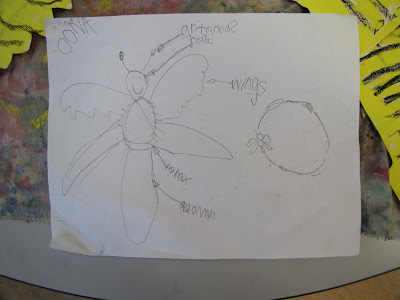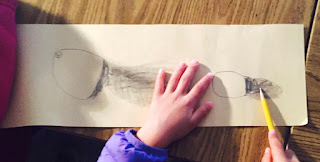Saturday, February 25, 2017
Friday, December 9, 2016
Kindergarten Outdoor Painting Experience. The science of joy
https://www.youtube.com/watch?v=VXRtZxo1lZo&sns=em
Best,
Claire
Monday, March 7, 2016
Tonal Values Drawing Lesson 1st Grade - Mar 7, 2016
I set up some oranges and plastic eggs, side lit by a clear light bulb, all other lights off and blinds closed. This was so the students could clearly see the way that the objects were illuminated on the lit side,dark on the unlit side and the shadows cast.
They used the big fat writing pencils that are considered best for learning in this country; I chose them because they have nice leads that can achieve a range of grays, and are good for side or normal grip when drawing in the shading.
At some point after the middle of the session I showed them a black & white photo of the still life. But I really wanted them to see through their own eyes and focus on light, dark, and mid tones.
Tuesday, March 1, 2016
Opossum - 1st Grade
Tuesday, January 19, 2016
1st Grade Monkey Joy
Tuesday, August 23, 2011
Teen Girls Media Literacy Mural (High School)
In collaboration with Precita Eyes Muralists and KQED Public Media, I conceived and directed a teenage girls' mural project that taught media literacy by seeing murals as a form of media.
KQED Education Supervisor Maxine Einhorn visited our group of girls aged 14-19 at Precita Eyes Muralists, and gave a presentation on media literacy. She showed videos and conducted a discussion with the girls about ways the various forms of media convey messages. We discussed the ways women and girls are portrayed in media through advertising and other content.
We created a mural measuring 12 feet wide by 5 feet high with the idea of someday posting it as a billboard: empowerment by creating one's own media--and message.
I facilitated the girls' design of their mural by taking written notes as they listed and brainstormed ideas; they then drew sketches for imagery they wanted in the mural. They created several designs that organized their imagery, and voted on a final design.
The girls painted the mural on Tyvek® indoor/outdoor paper using acrylic paint formulated for murals. Against a background of a shattered mirror, the mural contains images of women and girls doing sports, teaching math, speaking out, being president, and building their own identity. Also included are Rosie the Riveter, and a diverse range of women from varied age groups and ethnicities. The girls named the mural "Got Power?" as a spin on the milk ad campaign.
Thursday, May 13, 2010
Learining to Love Our Pollinators: Butterflies (all grade levels)




The Anise Swallowtail Butterfly Life Cycle
Using drawing, painting, clay, and paper sculpture, the students made the life cycle of the Anise Swallowtail butterfly, learning of its importance as a native pollinator. They made butterflies using re-purposed manila file folders as wings, and bodies of wire covered with self-hardening clay. They colored the wings with oil pastel and tempera paint, and painted the bodies with tempera. They made caterpillars and eggs out of self hardening clay, and colored them with markers. They also drew murals of fennel and pelletory, host plants for the Anise Swallowtail and Red Admiral butterflies, respectively. The murals included the eggs, caterpillars, butterflies, and chrysalises. The students made pencil diagrams and incorporated writing into them in the form of labels, indicating all of the parts of the butterflies such as head, thorax, abdomen, wings, veins, legs, antennas, proboscis, and other relevant terms relating to the life cycle. They created other written works such as small books, letters, and stories. Finally, they made large paper “cocoons” in which to carry their butterflies home. Some classes also did brief theater pieces with improvised singing and dancing about the butterflies.
Curriculum Connection:
Building a 2- and 3-dimensional work of art, drawing from observation, recognizing pattern and shape, clay building techniques using coil and and ball construction, group skills on mural drawings. Development of fine-motor skills and eye-hand coordination.
Monday, April 26, 2010
Honeybee Science Art Project-Learning to Love Our Pollinators: Honeybees (all grade levels)






Cleveland Elementary School Honeybee Project / Spring 2010
Curriculum developed and implemented by Claire Bain
Sponsored by Leap...Imagination in Learning
Kindergarten and First Grade / 12-week program
An in-depth project constructing honey bees and flowers out of (mostly recycled*) paper. Students learned basic anatomy of bees, their role as pollinators, basic anatomy of flowers, and the concept of pollination being necessary for the formation of seeds, fruits and vegetables.
Some of the art skills developed were: discerning and creating shape, composition, pattern, line, form, color nuances, and two- and three-dimensional form. There were several small projects over the course of the residency to teach specific lessons in line, pattern, drawing, cutting, painting, oil pastels, layering of art materials, and more. The kids performed theater pieces in class enacting the dance that bees actually do to communicate the location of flowers.
In addition to the art concepts, this program included many science, math, and writing concepts such as small animal and plant anatomy, pattern, addition, symmetry, and writing bee-related terms in English or Spanish. The students learned the main body parts of bees: head, thorax, abdomen, eyes, antennae, proboscis, pollen sacs, and veins (and their function) in the wings. They understood how and where those body parts were connected, and the fact that the fur on the bees’ legs and bodies serves as a carrier of pollen from flower to flower. They learned the major parts of flowers: petals (and their veins), the center of the flower where pollen is and seeds form. They experienced the scent of real orange blossoms in a demonstration of the way scent attracts bees. They learned and performed the dance that bees do to communicate to their co-workers the location of nectar sources (flowers), and enacted their bees buzzing from flower to flower collecting nectar and pollen. They also became clear on the fact that bees make honey in their hives using the nectar that they collect from flowers.
Over the 12-week program, the classroom teachers and I revisited the art techniques, science concepts, and math concepts that are connected to bees, pollination and flowers. The teachers incorporated the project into their classrooms through writing, reading, and math. Ms. Huerta (Kindergarten, bilingual Spanish) had her students write sentences about bees on a large poster which she displayed in the classroom, along with a labelled bee diagram. Ms. Baker-Cohn (First grade, English) read a beautiful poem in English and then in Spanish about beehives in Guerrero, Mexico; she also had her students draw hexagons, a reference to the honeycomb and also to math concepts. Ms. Eros (First grade, English) had her students write stories about bees. They and the other teachers also did other activities related to bees. For the school's special Art Show Night, the teachers hung all of the bees in the 2nd floor elevator vestibule in a giant "beehive" installation, complete with large hexagons drawn on wax paper by the kids to simulate a honeycomb.
The students had fun, learned to appreciate bees and their important role as pollinators, and also improved their own team-building and social skills. In addition, they were presented with basic concepts of plant and animal interdependency, which will be revisited in their 2nd and 4th grade science studies. A favorite moment of mine was overhearing 1st graders playing with the plastic shape manipulatives in their free time--they were arranging hexagons into honeycombs.
Note:
*The paper used in the bees consisted of discarded manila file folders and plastic sheet protectors which I obtained at San Francisco’s SCRAP (Scrounger’s Center for Reusable Art Parts http://www.scrap-sf.org/). The flowers were made from expired monthly calendars from the San Francisco library. Re-purposing these materials prevented the sheet protectors from ending up in the landfill, and conserved the energy and resources that would have been used in recycling the folders and calendars. This reinforced in the students the sense that we can re-use and repurpose materials. Additionally, they learned to correct their mistakes on the paper I gave them instead of starting over, a basic teaching approach I always use.
Tuesday, January 19, 2010
3rd, 4th, 5th Grade Architecture/Writing House Projects



Scale Model House Project
Architecture and Writing Program
Garfield Elementary School
Artist/Instructor: Claire Bain
Assisted by Linda Lam and Leslie Fleming
Sponsored by Leap...Imagination in Learning

With the knowledge and understanding gained previously by working in groups creating large-scale house models, they were able to design rooms large enough to accommodate furniture and space to move about.
A larger scale (1 inch = 1 foot) house model made by a group of students.
They then built the corresponding walls out of corrugated cardboard, and painted them.
When the models were dry, they drew the doors and windows using colored ink markers. They looked at examples of door and window styles from San Francisco, Burkina Faso (Africa) and India. They also used templates of doors and people as guides for placement and size of doors and windows.
During this project, they also wrote stories and poems about architecture, including mysteries and animal architecture.
Some of the goals accomplished by the project were:
- learning/reinforcing concepts of scale
- learning concepts of imagining a usable, livable home
- learning basic drafting skills
- learning vocabulary words from architecture and geometry
- using imagination in writing to create characters, stories, and spaces
- in writing: identifying tone; analyzing word choice; understanding poetic structure; understanding character, main idea, plot, text structure, and historical context
For more information: CBainArtEd.blogspot.com artistabain@yahoo.com Leap4kids.org
Wednesday, November 11, 2009
Facial Expression Drawings: Kindergarten and First Grade



 Please click on images to view full-size.
Please click on images to view full-size.

These drawings were made by Kindergarten and First grade students. They were given a set of line drawings that I made by observing photographs in a book on body language. Before the children drew, we sat together and looked at my drawings, discussing which emotions were expressed, and what happens to the face when it expresses each emotion. We acted out the emotions of happiness, sadness, fear, surprise, anger, and disgust, one by one. With each emotion we observed what happens to the eyebrows, eyes, nose, cheeks, and mouth. We also discussed what shapes were to be found on the human face, such as ovals (the whole face), "pointy ovals" (or lemon shapes-the eyes), circles (the iris and pupils), parenthesis (the sides of the nostrils), "v" shapes (the area between the nosrils), etc.
The children then went to their tables and drew by observing the line drawings I had made. They used markers; it was not necessary for them to draft and re-draft the drawings.
This was a 60-minute class period.
















